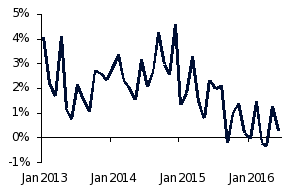Economic Commentary
Not long ago, it was difficult to imagine a future without rising global trade and deepening economic integration. Governments pushed through trade liberalisation policies, firms cooperated to develop global supply chains and the result was increasing trade flows that drove global growth. But now nearly eight years since the start of the global financial crisis, much has changed. Trade has slowed in both value and volume terms, including falling below global growth in three of the past four years.
Growth of global trade volumes has averaged 3.9% per year since 2011, down from an average of 7.3% from 2000 to 2007. Moreover, recent data shows that the state of global trade has deteriorated even further. Through the first six months of 2016, global goods trade volumes have averaged just 0.1% year-over-year growth, the slowest rate since the financial crisis.
There have been three major factors underlying the slowdown of global trade. The first factor has been the cyclical downturn in aggregate demand emanating from advanced economies. In the aftermath of the financial crisis, the process of gradually rebuilding balance sheets and deleveraging had a protracted negative impact on consumption and investment.
The high import content of these components, combined with advanced economies accounting for over 60% of global imports resulted in a dampening of global trade. Advanced economies’ real GDP growth fell from an average of 2.6% per year from 2000 to 2007 to an average of 1.6% from 2011 to 2015. In response, import growth in advanced economies dropped by nearly half from 6.2% to 3.6% over the same respective periods.
The second factor has been the influence of structural reforms in China. Chinese authorities have enacted policies aimed at increasing the on-shoring of production and rebalancing away from the import-intensive investment and export sectors to foster consumption-led growth.
Considering that China accounts for 10% of global goods imports, the impact of these policies will directly slow trade by lowering Chinese imports of capital and intermediate goods. There will also be indirect effects by weakening China’s demand for exports from other Asian countries who depend on linkages to China through global value chains (GVCs) and commodity exports.
Global imports of goods
(volumes; year-over-year)

Sources: Netherlands Bureau for Economic Policy Analysis (CPB)and QNB Economics
Indeed, the gradual influence of this shift has already materialised. According to the International Monetary Fund, Chinese import growth declined from an annual average of 13.1% over 2006 to 2011, to 6.1% from 2012 to 2015, of which approximately half was attributable to China’s economic rebalancing.The remaining portion of the decline reflects the weakness in aggregate demand.
The third factor has been the rise of protectionism and slower rate of trade liberalisation. Despite numerous pledges to support trade from the G20, including their most recent meeting in June, member states have increasingly been enacting protectionist measures. Based on the database assembled by Global Trade Alert, discriminatory trade measures increased by 50% in 2015, of which more than three-fourths were from G20 member states.
Additionally, the pace of trade liberalisation has slowed as evidenced by fewer major trade agreements and the difficulty of finalising some of the major deals that have been agreed to in principle. For example, the much heralded Trans-Pacific Partnership (TPP) is yet to be approved by the US Congress and negotiations over the US-EU trade agreement have dragged on for more than three years. This sentiment has been accompanied by politics that is increasingly hostile to globalisation, clearly seen in the recent successful Brexit campaign in the UK and the strong support for anti-trade positions in the current US presidential election campaign.
What are the implications of slower global trade? The deepening economic integration between countries and the reliance on trade as a source of growth will be increasingly challenged. In particular, emerging market countries will have to look inwards and consider structural reforms to unlock alternative sources of growth.
Additionally, the slowing expansion of GVCs that is likely to be accompanied with weaker trade could lower productivity growth. GVCs have been effective purveyors of productivity enhancement by encouraging specialisation and technological diffusion.
Global trade has faltered considerably, declining to its slowest pace of growth since the financial crisis. The weakness reflects both cyclical and structural factors, including already weaker Chinese imports and the rise of protectionism. Looking to the future, countries will have to find alternative sources of growth. For example, the world is becoming increasingly digitalised and the flow of information is growing while trade flows decline, a phenomenon that is being called digital globalisation. This could present opportunities in the future.
Disclaimer and Copyright Notice: QNB Group accepts no liability whatsoever for any direct or indirect losses arising from use of this report. Where an opinion is expressed, unless otherwise provided, it is that of the analyst or author only. Any investment decision should depend on the individual circumstances of the investor and be based on specifically engaged investment advice. The report is distributed on a complimentary basis. It may not be reproduced in whole or in part without permission from QNB Group.
